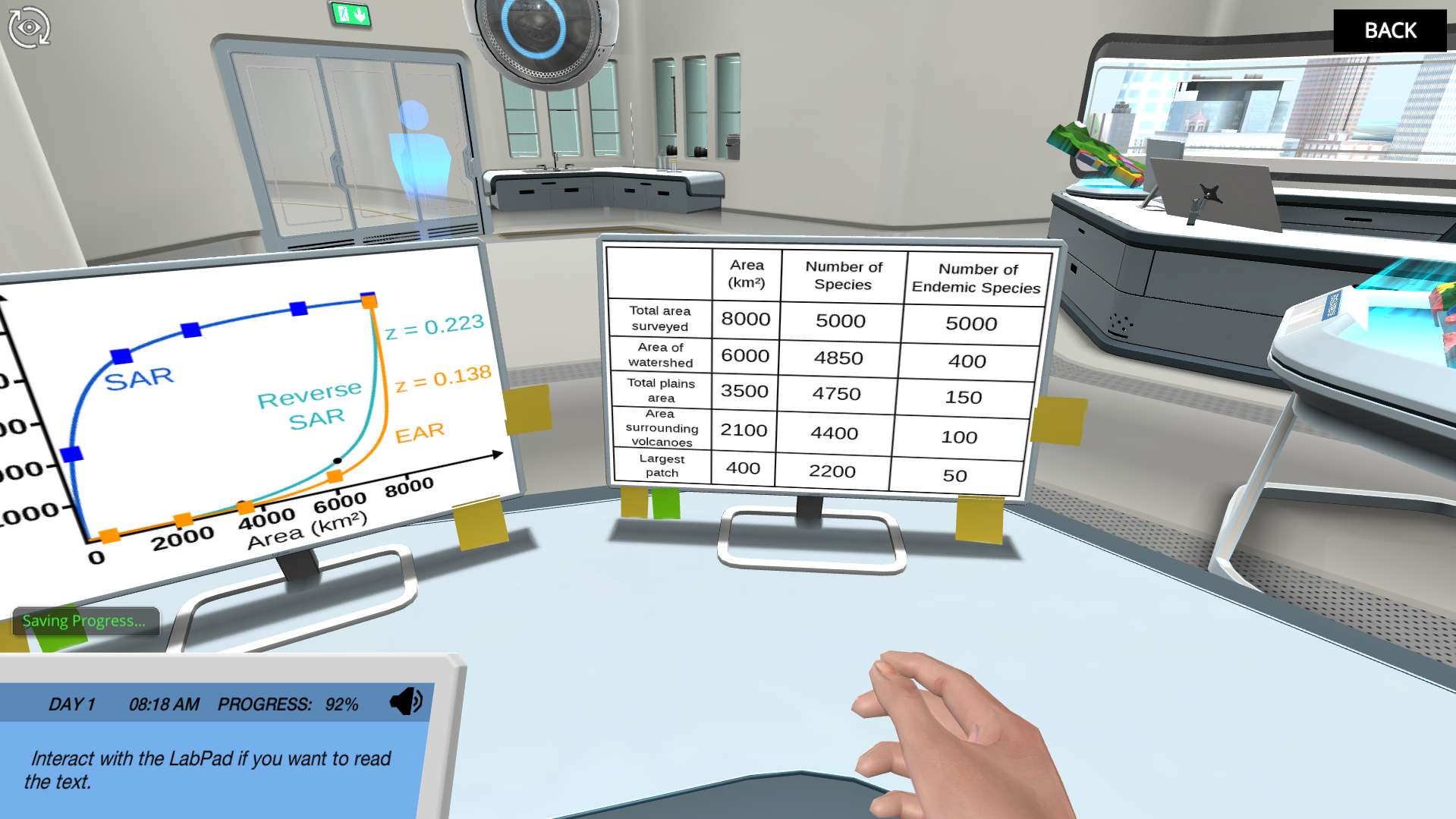Heading 1
Heading 2
Heading 3
Heading 4
Heading 5
Heading 6
Lorem ipsum dolor sit amet, consectetur adipiscing elit, sed do eiusmod tempor incididunt ut labore et dolore magna aliqua. Ut enim ad minim veniam, quis nostrud exercitation ullamco laboris nisi ut aliquip ex ea commodo consequat. Duis aute irure dolor in reprehenderit in voluptate velit esse cillum dolore eu fugiat nulla pariatur.
Block quote
Ordered list
- Item 1
- Item 2
- Item 3
Unordered list
- Item A
- Item B
- Item C
Bold text
Emphasis
Superscript
Subscript
About This Simulation
Discover unique areas within an exoplanet’s landscape and apply your findings to predict the persistence of an alien species by estimating colonization and extinction rates.
Learning Objectives
- Determine factors that affect the location of patches within a landscape
- Calculate species extinction rates using species-area and endemics-area theory
- Estimate species extinction and colonization rates in a heterogeneous landscape
- Explain the impact of landscape spatial heterogeneity on population dynamics
About This Simulation
Lab Techniques
- Species's persistence prediction
- Determine colonization probability
- Species-Area Relationship
- Analyze data on species' dispersal capabilities and specialization
Related Standards
- High level content, could support HS-LS2-6
- No direct alignment
- No direct alignment
Learn More About This Simulation
Not all areas within a landscape are created equal. When studying ecological processes in an environment, it is important to remember that landscapes may be spatially heterogeneous. In this simulation, you will learn to identify and compare unique patch types on the exoplanet Astakos IV and use their specific characteristics to help understand local population dynamics. Bioengineers need your help applying the principles of landscape ecology to determine if the persistence of the Propella species on Astakos IV is in danger.
Predict the Propella’s persistence on Astakos IV
A bioengineer has become fascinated by an interesting species on Astakos IV called the Propella that can generate energy from wind power. However, her team will not arrive from Earth for many years and she wants to know if the Propella species will continue to survive after the recent volcano eruptions and human growth on the planet. Using the principles of landscape ecology, you will examine colonization and extinction rates to predict the chance of the Propella’s persistence.
Determine colonization and extinction rates
You will use a variety of methods to estimate both colonization and extinction rates, which you will use together to predict the Propella’s population dynamics. Firstly, you will be tasked with interpreting GIS maps to identify a variety of different landscape patch types and paint a full mosaic of the landscape. Using impressive data visualization techniques layered on an interactive 3D map, you will analyze dispersal capabilities and specialization levels of a variety of species to help predict the colonization probability of the Propella. Extinction rates will be analyzed using both Species-Area Relationship and Endemics-Area Relationship. Finally, you will combine all of the accumulated data and landscape ecology principles to summarize the impact of recent volcano eruptions and human growth on the Propella’s population.
Suggest actions to improve persistence
You will complete your application of landscape ecology principles to predict the Propella’s chance of persistence and even suggest specific measures that could help increase the likelihood of its survival. Will you be able to help the bioengineers ensure that the Propella will be around long enough to learn its secrets?
For Science Programs Providing a Learning Advantage
Boost STEM Pass Rates
Boost Learning with Fun
75% of students show high engagement and improved grades with Labster
Discover Simulations That Match Your Syllabus
Easily bolster your learning objectives with relevant, interactive content
Place Students in the Shoes of Real Scientists
Practice a lab procedure or visualize theory through narrative-driven scenarios


FAQs
Find answers to frequently asked questions.
Heading 1
Heading 2
Heading 3
Heading 4
Heading 5
Heading 6
Lorem ipsum dolor sit amet, consectetur adipiscing elit, sed do eiusmod tempor incididunt ut labore et dolore magna aliqua. Ut enim ad minim veniam, quis nostrud exercitation ullamco laboris nisi ut aliquip ex ea commodo consequat. Duis aute irure dolor in reprehenderit in voluptate velit esse cillum dolore eu fugiat nulla pariatur.
Block quote
Ordered list
- Item 1
- Item 2
- Item 3
Unordered list
- Item A
- Item B
- Item C
Bold text
Emphasis
Superscript
Subscript
A Labster virtual lab is an interactive, multimedia assignment that students access right from their computers. Many Labster virtual labs prepare students for success in college by introducing foundational knowledge using multimedia visualizations that make it easier to understand complex concepts. Other Labster virtual labs prepare learners for careers in STEM labs by giving them realistic practice on lab techniques and procedures.
Labster’s virtual lab simulations are created by scientists and designed to maximize engagement and interactivity. Unlike watching a video or reading a textbook, Labster virtual labs are interactive. To make progress, students must think critically and solve a real-world problem. We believe that learning by doing makes STEM stick.
Yes, Labster is compatible with all major LMS (Learning Management Systems) including Blackboard, Canvas, D2L, Moodle, and many others. Students can access Labster like any other assignment. If your institution does not choose an LMS integration, students will log into Labster’s Course Manager once they have an account created. Your institution will decide which is the best access method.
Labster is available for purchase by instructors, faculty, and administrators at education institutions. Purchasing our starter package, Labster Explorer, can be done using a credit card if you are located in the USA, Canada, or Mexico. If you are outside of North America or are choosing a higher plan, please speak with a Labster sales representative. Compare plans.
Labster supports a wide range of STEM courses at the high school, college, and university level across fields in biology, chemistry, physics, and health sciences. You can identify topics for your courses by searching our Content Catalog.















